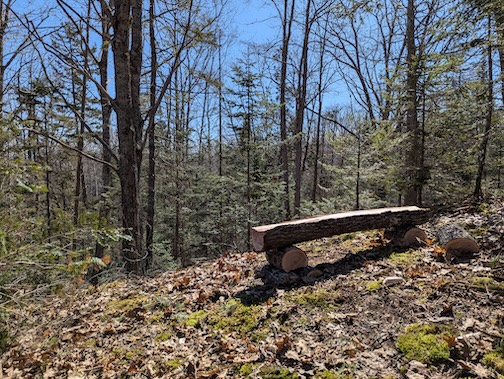By Maddie Eberly, Low-Impact Forestry Specialist

Maine has a strong history of landowners allowing access to privately owned woods for neighbors and community members to wander across boundaries (Maine law protects landowners from much in terms of liability). Usually, this includes communication between landowner and wanderer. As time has progressed, the permitted access to land hasn’t always been well respected, with people over-harvesting resources from the land, leaving behind litter, or creating disturbances in an otherwise peaceful place. This has led many landowners to post “No Trespassing” signs along their boundaries or paint purple blazes, dotting the landscape within every hundred feet. (“OSHA Safety Purple” blazing can be used in place of “No Trespassing” signage.) If a shot deer (or any game animal) crosses a boundary line, the hunter is still able to track and collect the animal with landowner consent. It should be noted, in Maine, it is illegal to hunt on Sundays.
In an attempt to continue Maine’s tradition of accessible lands, the Open Space Tax Law allows landowners to value their lands as open space, or land accessible and designated for the public. This is a similar program to Maine’s Tree Growth Tax Law, which incentivizes landowners to enroll through a tax break and helps to make sustainable and community-focused land management happen.
Still, funding the building of trails can be tricky. The Maine Trails Coalition has a great web page of resources for trail builders. For organizations, grant opportunities such as the Maine Trails Program, a Maine Bureau of Parks and Lands grant, are available to organizations and municipalities, but for a landowner it can be most cost effective to pair trail work with other forest activities, such using skid trails from a recent timber harvest to build out walking and skiing trails. The Natural Resources Conservation Service (NRCS) has a Trails and Walkways cost-share program that can also fund the creation of new trails on private lands. Reach out to your forester or district conservationist to learn more.

When building trails, it is important to be thoughtful in the design of your path. If you have the funds, there are trail design consultants that work in Maine. However, it is unrealistic for most landowners to hire someone to do this work. The first thing to do is walk in your woods. Find those special places you want to visit more often, such as a good spot to camp or sit. Plan around — and with — your forest management intentions, connecting these places together with care and thoughtfulness to avoid soil erosion and compaction, or wetland disturbance. It would be best to avoid building the trail along or through wet areas that are more sensitive to the disturbance of passing feet.
Consider who will be using the new trail. Will the visitors include individual people or those who hope to walk side-by-side? Perhaps ATVs or bikes will travel these paths? Plan the width, slope, and potential interactions with hazards (like roots and rocks!) accordingly. It is sometimes joked about amongst East Coast hikers that many classic trails in the Northeast take an aggressively direct path straight up a slope. Avoid building a classic northeastern trail as it not only tires out the hiker but also can lead to erosion issues long term. Instead wander the trail on gentler terrain, creating switchbacks and adding in water bars to keep the water erosion to a minimum. Stepping stones or bog bridges might help one traverse wet terrain without disturbing the soil, but be sure to comply with any state or local ordinances. Again, a crew can be hired to build this fun new addition to your woodlot, but more than likely you, your friends, and/or your family will be picking away at this work. Take your time, be thoughtful and safe, and have fun!
This article was originally published in the summer 2025 issue of The Maine Organic Farmer & Gardener.